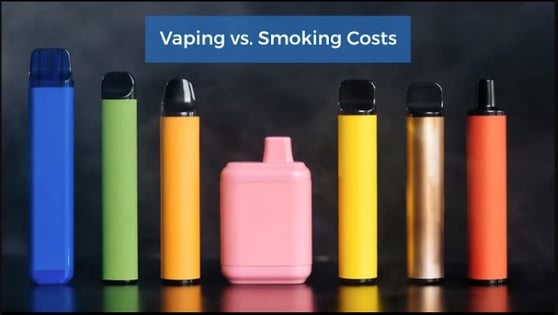Vaping vs. Smoking
.jpeg?width=250&name=AdobeStock_116129137%20(1).jpeg)
Both vaping and smoking are common ways to deliver nicotine. However, smoking presents severe health hazards because it involves burning tobacco and inhaling the resulting smoke. Vaping presents reduced health concerns because it uses safer alternatives for delivering nicotine. Learn more about the differences between vaping vs. smoking and the benefits of switching to vaping instead of smoking.
Vaping Is Less Harmful Than Smoking
Is vaping better than smoking? While experts have concluded that vaping isn't risk-free, it presents far fewer health concerns than conventional smoking. For example, vaping exposes users to lower levels of toxins than smoking, as cigarettes contain approximately 7,000 chemicals, many of which are toxic and can cause cardiovascular disease, cancer, and an increased risk of heart attacks or strokes. Vape liquid has extracted nicotine, flavorings, and chemicals that help aerosolize the liquid. People who want to use vaping as a method for quitting smoking can drastically reduce their exposure to these health risks.
However, vaping has been associated with lung injuries and death, particularly among users who modify their equipment or use vape liquids or e-cigarettes from unregulated sources. THC vaping products, especially, can be dangerous. The CDC encourages vape users to stay away from e-cigarettes and vaping products with THC and to not purchase materials through informal, unregulated sources. Also, the CDC discourages vaping any substances not recommended by the manufacturer. By following these recommendations, people can vape far more safely than they can smoke.
Vaping vs. Smoking Costs
Another consideration in the vaping vs. smoking debate is the associated costs. Vape pens and e-cigarettes can cost as little as one-third of the cost of conventional cigarettes. Heavy smokers can see even more significant cost savings:
- Replacing five cigarettes a day: 76% cost reduction
- Replacing ten cigarettes a day: 88% cost reduction
- Replacing 20 cigarettes a day: 93% cost reduction
These percentages represent direct cost savings. By switching to this less dangerous alternative, users can also see reduced healthcare costs and lower their risk of expensive treatments or doctor visits in the future.
Benefits of Switching From Smoking to Vaping
Cost is a key potential benefit of switching to vaping products, but it's far from the only benefit that consumers can experience. Other benefits of making the switch include:- Replacing smoking with a better habit: Quitting smoking can be a very difficult decision, as cigarette addiction makes quitting cold turkey uncomfortable, distressing, and prone to failure. However, alternative or transitional habits such as vaping still provide nicotine but with fewer drawbacks. This can ease the journey to cutting out smoking, especially as an immediate switch.
- Reducing the risk of cancer: Smoking has been found to cause at least 15 types of cancer. Eliminating a smoking habit can drastically bring down those risks, even for people with a long history of smoking. Because vaping can help people transition away from smoking, it's a vital tool in reducing cancer risks and other health concerns associated with cigarettes.
- Removal of tobacco: Health organizations recommend the entire elimination of direct tobacco use because there is no safe amount of cigarette smoking. Nicotine can help users meet that recommendation. Vape liquid has nicotine that is extracted from tobacco but doesn't have many of the other harmful chemicals in cigarettes.

